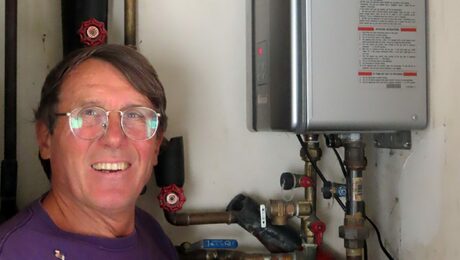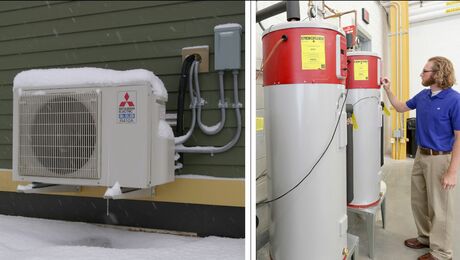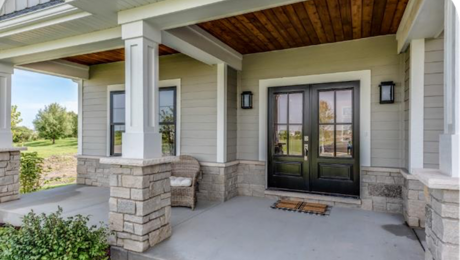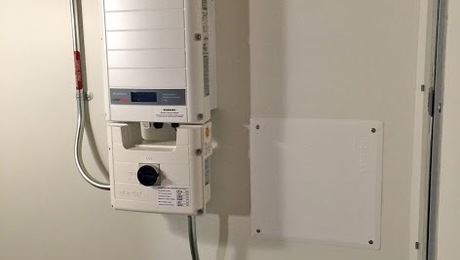Heating and ventilating a very small space
My wife and I will soon be building a 250 square-foot in-law unit in our backyard in the Bay Area in California. The unit will have a bathroom and a great room with kitchenette and living space. It’ll be built on a slab with advanced framing and sealed as well as we can. It’ll have a gable roof and a cathedral ceiling.
We were originally planning to heat the space using a radiant floor system and ventilate with a standard bathroom exhaust and range hood, but after reading articles on this website, I’m not sure that’d be the most effective solution.
For such a small space, how do you think we should heat and ventilate the home?
Thanks.
GBA Detail Library
A collection of one thousand construction details organized by climate and house part









Replies
This project is tailor-made for a mini-split or even, for much less money but slightly noisier, a thru-wall package unit. Your vent suggestions will be fine - crack a window to supplement when necessary. Radiant floor makes no sense in a well-insulated space in a mild climate: see the recent articles in the GBA blog section.
Nick,
Only 250 square feet in the Bay area? An argument could be make for electric resistance baseboard. Tiny space, and a climate without much of a winter...
If it is well insulated and sealed you could probably get away with some incandescent bulbs for heat. Actually, I'm not quite serious. Martin's suggestion of baseboard heat is good, you might even use a freestanding electric heater for the few days a year you need it. A good bath fan would give you all the ventilation you need since likely you will keep windows open much of the year.
I've never heard of it freezing in the bay area, so the only real risk not having central heat is discomfort. If whoever stays there is willing to dress warmly you may never need any heat at all.
Take it a step further and just use a free-standing electric space heater. If the building is well-positioned to take advantage of solar gain, you may not need much heat at all. Why pay any installation cost at all when needs are so low? The bath fan should work fine as ventilation, assuming an 80 CFM fan and a short, straight duct run that doesn't lose much flow.
agreed that 250 sf is very small
however, San Fransisco is not exactly an extremely mild winter (like LA)
when I googled Heating Degree Days it shows around 2800 HDD
maybe a couple of first generation Plasma TV's would work ;--)
Thanks Gents for your suggestions. I like the baseboard heating option combined with a bathroom exhaust. We even thought about just turning on the oven for 10 minutes at a time in the evenings during winter. A space heater could work too.
Just to stir the pot and be a bit of a contrarian I think it's not outrageous to use a radiant slab in a little guest house like this. The parts would cost around $950 and it's nice heat, silent, and takes up no floor space. We did a little (600 sf) horse barn to guest house conversion like this here in NC off a 20 gallon under-counter electric water heater tucked into a corner cabinet in the kitchenette. (access door is adjacent to dorm fridge in attached image, water heater heat exchanger and pumps all fit in corner cab w/ rectangular sheet metal drain pan.)
Clients report that they have no issues with taking hot showers on cold days and that the electric bills have not been excessive. There are cheaper ways to get electric heat into a guest house but this is pretty classy and is much appreciated by their guests.
I would be concerned that a high mass system in a small, low-demand building is going to be hard to manage. It could work, but given that no one is living there full-time, it will take some effort to get comfortable temps when needed without under- or over-shooting.
Michael, that's $950 vs $30 for the baseboard heater. On a 250 foot building that's quite a sizeable jump in the budget for warm feet.
Also, keep in mind that there are some fast temperature swings in the bay area. While it rarely gets very hot, the temperature can change quickly, something that radiant floor heat will have a hard time keeping up with. The house may heat up in the morning, then be too hot when the sun comes out. At 250 SF, a tight house would stay pretty warm without any extra heat most of the time if managed properly
Malcolm I do understand that it's a jump but the numbers are all skewed for these tiny houses. Look at the picture above, we have all wood interior paneling finished with real shellac so it will age better, spray foam, integrity windows, double drawer dishwasher for tiny loads. and then we have a two burner table top hot plate recessed into the copper counter top an under-counter fridge and a toaster oven.
With a well insulated and air sealed high mass building the radiant floor doesn't need to kick a huge amount of BTUs at any given time so it works out well so long as you don't expect to drop the t-stat to 50 for a week an then walk in on Friday and have it be 78 degrees in thirty minutes when it's 30 degrees outside. If you can give it six hours to come up to temp you'll be fine.
As the original poster, I appreciate the discussion. We're considering just using a portable space heater. Cheap and effective.
Another question I have concerns how to insulate our cathedral ceiling. We're planning to use 10" rafters and to fill the cavities with blown cellulose. No venting. Then we'll add some rigid foam on the outside of the sheathing with standard asfault shingles to top it off. Basically the way it's shown in the detail drawings available on this site.
Considering our location, bay area calif., do you think this is a good way to go? We're not really interested in spray foam.
Nick,
If you insulate a cathedral ceiling with cellulose only, you must include a ventilation channel between the top of the insulation and the roof sheathing. [Later edit: I see now that this answer is confusing, because I misunderstood your question. If you include an adequate thickness of rigid foam above the roof sheathing, you may proceed with an unventilated roof assembly. Sorry for the confusion.]
For more information, see
https://www.greenbuildingadvisor.com/blogs/dept/musings/how-build-insulated-cathedral-ceiling
Martin,
Could we add 2 inches of rigid foam insulation in the rafter cavity first (foamed at the joints) and then fill the remainder of the cavity with blown cellulose? We could still then add more rigid insulation between the roof decking and the shingles.
I'm not opposed to any one idea. I'd just like to go with a simple, efficient, and cheap method for making a well-insulated envelope. Cellulose seems to be the cheapest and greenest insulation. I never thought this part of the design would be the most complex :)
"Air-permeable insulation (like fiberglass) is risky, since it allows moisture-laden air to reach the cold roof sheathing. If you want to use air-permeable insulation in this location (between the rafters), you have two choices: include a ventilation channel between the top of the insulation and the underside of the roof sheathing, or install rigid foam insulation on top of the roof sheathing to keep the sheathing warm. (Don't do both, since these two solutions are incompatible.)" - from Creating a Conditioned Attic
Now I'm confused. In an earlier post I was told that I'd have to add rafter venting if I wanted to fill the rafter cavities with cellulose and use rigid foam above the roof decking. But in this quote from one of the GBA articles, it says that I shouldn't use rafter venting if I use cellulose in the rafters and rigid foam above the decking. Which is it? Have opinions changed on the matter in two years?
Nick,
Q. "Could we add 2 inches of rigid foam insulation in the rafter cavity first (foamed at the joints) and then fill the remainder of the cavity with blown cellulose?"
A. That approach is much fussier than spray foam, but it will work if you are very meticulous about air sealing. Your suggestion to use R-10 foam will work in your climate, but GBA readers should be aware that in colder climates, you'll need thicker foam (R-15 for Climate Zones 4A and 4B, R-20 for Climate Zone 5, R-25 for Climate Zone 6, R-30 for Climate Zone 7, and R-35 for Climate Zone 8) for this approach to work.
Nick,
Q. "Now I'm confused. In an earlier post I was told that I'd have to add rafter venting if I wanted to fill the rafter cavities with cellulose and use rigid foam above the roof decking."
A. Please post a link to the advice you are referring to. As my article correctly noted, you have three choices if you want to install cellulose in a cathedral ceiling. Either:
(1) Install an adequate amount of rigid foam above the roof sheathing,
(2) Install an adequate amount of closed-cell spray foam (or conceivably, sealed rigid foam) on the underside of the roof sheathing, or
(3) Install a ventilation gap between the top of the cellulose insulation and the underside of the roof sheathing.
The article correctly warned against combining a ventilation gap under the sheathing with foam above. After all, you don't want cold outdoor air flowing through the middle of an insulation sandwich; otherwise the insulation above your roof sheathing will be useless.
Martin,
Now I am confused
Look back at Nick's post 12 ...
it looks to me like your suggestion (1) in post 17
John,
Thanks for the reference. I see now that I missed a sentence in Nick's question in post #12. If there is enough foam above the sheathing, then it is possible to proceed with an unvented roof assembly.
I apologize for the confusion.
Thanks for the clarification.